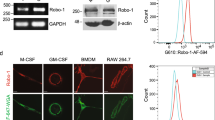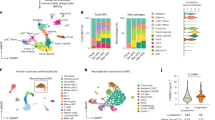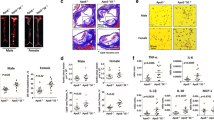Abstract
The appearance of lipid-rich foam cells is a major feature of vulnerable atherosclerotic plaque formation. The transformation of macrophages into foam cells results from excessive uptake of cholesterol-rich particles by scavenger receptors such as CD68. We cloned a CD68-Fc immunoadhesin, a fusion protein consisting of the extracellular domain of the human CD68 and a human Fc domain, and investigated the function in vitro. Specific binding of CD68-Fc to OxLDL with an affinity of 10 nmol/L was determined by surface plasmon resonance and increased binding to lipid-rich human and ApoE−/− mice plaque tissue. This was confirmed both by immunohistochemical staining of CD68-Fc-treated paraffin sections from human plaques and by ELISA-based quantification of CD68-Fc binding to human atherosclerotic plaque extracts. In an in vitro model of macrophage/foam cell formation, CD68-Fc reduced foam cell formation significantly. This was caused both by interference of CD68-Fc with OxLDL uptake into macrophages and platelets and by the inhibition of platelet/OxLDL phagocytosis. Finally, expression of metalloproteinases by macrophages/foam cells was inhibited by CD68-Fc. In conclusion, CD68-Fc seems to be a promising new tool for preventing macrophage/foam cell formation. Thus, CD68-Fc might offer a novel therapeutic strategy for patients with acute coronary syndrome by modulating the generation of vulnerable plaques.






Similar content being viewed by others
References
Badimon L, Martinez-Gonzalez J, Llorente-Cortes V, Rodriguez C, Padro T (2006) Cell biology and lipoproteins in atherosclerosis. Curr Mol Med 6:439–456
Stoll G, Bendszus M (2006) Inflammation and atherosclerosis: novel insights into plaque formation and destabilization. Stroke 37:1923–1932
Moore KJ, Freeman MW (2006) Scavenger receptors in atherosclerosis: beyond lipid uptake. Arterioscler Thromb Vasc Biol 26:1702–1711
Brown MS, Goldstein JL (1983) Lipoprotein metabolism in the macrophage: implications for cholesterol deposition in atherosclerosis. Annu Rev Biochem 52:223–261
Gough PJ, Gordon S, Greaves DR (2001) The use of human CD68 transcriptional regulatory sequences to direct high-level expression of class A scavenger receptor in macrophages in vitro and in vivo. Immunology 103:351–361
Falk E (2006) Pathogenesis of atherosclerosis. J Am Coll Cardiol 47:C7–12
Ramprasad MP, Terpstra V, Kondratenko N, Quehenberger O, Steinberg D (1996) Cell surface expression of mouse macrosialin and human CD68 and their role as macrophage receptors for oxidized low density lipoprotein. Proc Natl Acad Sci USA 93:14833–14838
Greaves DR, Gordon S (2005) Thematic review series: the immune system and atherogenesis. Recent insights into the biology of macrophage scavenger receptors. J Lipid Res 46:11–20
Li AC, Glass CK (2002) The macrophage foam cell as a target for therapeutic intervention. Nat Med 8:1235–1242
Llaverias G, Rebollo A, Pou J, Vazquez-Carrera M, Sanchez RM, Laguna JC, Alegret M (2006) Effects of rosiglitazone and atorvastatin on the expression of genes that control cholesterol homeostasis in differentiating monocytes. Biochem Pharmacol 71:605–614
Han J, Zhou X, Yokoyama T, Hajjar DP, Gotto AM Jr, Nicholson AC (2004) Pitavastatin downregulates expression of the macrophage type B scavenger receptor, CD36. Circulation 109:790–796
Van Berkel TJ, Out R, Hoekstra M, Kuiper J, Biessen E, Van Eck M (2005) Scavenger receptors: friend or foe in atherosclerosis? Curr Opin Lipidol 16:525–535
Fuhrman B, Koren L, Volkova N, Keidar S, Hayek T, Aviram M (2002) Atorvastatin therapy in hypercholesterolemic patients suppresses cellular uptake of oxidized-LDL by differentiating monocytes. Atherosclerosis 164:179–185
Bruni F, Pasqui AL, Pastorelli M, Bova G, Cercignani M, Palazzuoli A, Sawamura T, Gioffre WR, Auteri A, Puccetti L (2005) Different effect of statins on platelet oxidized-LDL receptor (CD36 and LOX-1) expression in hypercholesterolemic subjects. Clin Appl Thromb Hemost 11:417–428
Bays H (2006) Statin safety: an overview and assessment of the data—2005. Am J Cardiol 97:6C–26C
Massberg S, Konrad I, Bültmann A, Schulz C, Münch G, Peluso M, Lorenz M, Schneider S, Besta F, Müller I, Hu B, Langer H, Kremmer E, Rudelius M, Heinzmann U, Ungerer M, Gawaz M (2004) Soluble glycoprotein VI dimer inhibits platelet adhesion and aggregation to the injured vessel wall in vivo. FASEB J 18:397–399
Daub K, Langer H, Seizer P, Stellos K, May AE, Goyal P, Bigalke B, Schönberger T, Geisler T, Siegel-Axel D, Oostendorp RA, Lindemann S, Gawaz M (2006) Platelets induce differentiation of human CD34+ progenitor cells into foam cells and endothelial cells. FASEB J 20:2559–2561
Schmidt R, Bültmann A, Ungerer M, Joghetaei N, Bulbul O, Thieme S, Chavakis T, Toole BP, Gawaz M, Schömig A, May AE (2006) Extracellular matrix metalloproteinase inducer regulates matrix metalloproteinase activity in cardiovascular cells: implications in acute myocardial infarction. Circulation 113:834–841
Axel DI, Frigge A, Dittmann J, Runge H, Spyridopoulos I, Riessen R, Viebahn R, Karsch KR (2001) All-trans retinoic acid regulates proliferation, migration, differentiation, and extracellular matrix turnover of human arterial smooth muscle cells. Cardiovasc Res 49:851–862
Schönberger T, Siegel-Axel D, Bussl R, Richter S, Judenhofer MS, Haubner R, Reischl G, Klingel K, Münch G, Seizer P, Pichler BJ, Gawaz M (2008) The immunoadhesin glycoprotein VI-Fc regulates arterial remodelling after mechanical injury in ApoE−/− mice. Cardiovasc Res 80:131–137
Schulz C, Penz S, Hoffmann C, Langer H, Gillitzer A, Schneider S, Brandl R, Seidl S, Massberg S, Pichler B, Kremmer E, Stellos K, Schönberger T, Siess W, Gawaz M (2008) Platelet GPVI binds to collagenous structures in the core region of human atheromatous plaque and is critical for atheroprogression in vivo. Basic Res Cardiol 103:356–367
Brewer HB Jr (2000) The lipid-laden foam cell: an elusive target for therapeutic intervention. J Clin Invest 105:703–705
Brekke OH, Sandlie I (2003) Therapeutic antibodies for human diseases at the dawn of the twenty-first century. Nat Rev Drug Discov 2:52–62
Choudhury RP, Lee JM, Greaves DR (2005) Mechanisms of disease: macrophage-derived foam cells emerging as therapeutic targets in atherosclerosis. Nat Clin Pract Cardiovasc Med 2:309–315
Stockwin LH, Holmes S (2003) The role of therapeutic antibodies in drug discovery. Biochem Soc Trans 31:433–436
Oksjoki R, Kovanen PT, Lindstedt KA, Jansson B, Pentikainen MO (2006) OxLDL–IgG immune complexes induce survival of human monocytes. Arterioscler Thromb Vasc Biol 26:576–583
Griffith RL, Virella GT, Stevenson HC, Lopes-Virella MF (1988) Low density lipoprotein metabolism by human macrophages activated with low density lipoprotein immune complexes. A possible mechanism of foam cell formation. J Exp Med 168:1041–1059
Yuan ZY, Liu Y, Kishimoto C, Shioji K, Yokode M, Liu ZQ (2003) The Fc region of immunoglobulin suppresses atherosclerosis in apolipoprotein E knockout mice. Zhonghua Yi Xue Za Zhi 83:489–493
Nicoletti A, Paulsson G, Caligiuri G, Zhou X, Hansson GK (2000) Induction of neonatal tolerance to oxidized lipoprotein reduces atherosclerosis in ApoE knockout mice. Mol Med 6:283–290
Miura Y, Takahashi T, Jung SM, Moroi M (2002) Analysis of the interaction of platelet collagen receptor glycoprotein VI (GPVI) with collagen. A dimeric form of GPVI, but not the monomeric form, shows affinity to fibrous collagen. J Biol Chem 277:46197–46204
Ashkenazi A, Chamow SM (1997) Immunoadhesins as research tools and therapeutic agents. Curr Opin Immunol 9:195–200
Yung RL (2001) Etanercept Immunex. Curr Opin Investig Drugs 2:216–221
de Beer MC, Zhao Z, Webb NR, van der Westhuyzen DR, de Villiers WJ (2003) Lack of a direct role for macrosialin in oxidized LDL metabolism. J Lipid Res 44:674–685
Rouis M (2005) Matrix metalloproteinases: a potential therapeutic target in atherosclerosis. Curr Drug Targets Cardiovasc Haematol Disord 5:541–548
Laukkanen J, Lehtolainen P, Gough PJ, Greaves DR, Gordon S, Yla-Herttuala S (2000) Adenovirus-mediated gene transfer of a secreted form of human macrophage scavenger receptor inhibits modified low-density lipoprotein degradation and foam-cell formation in macrophages. Circulation 101:1091–1096
Jalkanen J, Leppanen P, Narvanen O, Greaves DR, Yla-Herttuala S (2003) Adenovirus-mediated gene transfer of a secreted decoy human macrophage scavenger receptor (SR-AI) in LDL receptor knock-out mice. Atherosclerosis 169:95–103
Levine SJ (2004) Mechanisms of soluble cytokine receptor generation. J Immunol 173:5343–5348
Rose-John S, Heinrich PC (1994) Soluble receptors for cytokines and growth factors: generation and biological function. Biochem J 300(Pt 2):281–290
Acknowledgments
We acknowledge the excellent technical assistance of Jadwiga Kwiatkowska, Christina Neff, Birgit Fehrenbacher, and Barbara Proksch. We also thank Maria Lissner and Lydia Kotchoubey of the Dept. of Transfusion Medicine for providing blood samples and Richard Brandl, Vascular Surgery, Krankenhaus München-Schwabing, Germany for providing specimens of carotid atherectomies.
Funding
The study was supported by grants of the Deutsche Forschungsgemeinschaft (Graduiertenkolleg [GK 794] and [GRK 438]) to M.G., K.D. and S.P. and Transregio-SFB-19 “Inflammatorische Kardiomyopathie”) and the Bundesministerium für Bildung und Forschung (BMBF) to D.S., M.G. and C.L.). M.S. was supported by the Deutsche Forschungsgemeinschaft (Sch 897/3, SFB-773 Z2).
Author information
Authors and Affiliations
Corresponding author
Additional information
Karin Daub, Dorothea Siegel-Axel, and Tanja Schönberger shared first authorship.
Rights and permissions
About this article
Cite this article
Daub, K., Siegel-Axel, D., Schönberger, T. et al. Inhibition of foam cell formation using a soluble CD68-Fc fusion protein. J Mol Med 88, 909–920 (2010). https://doi.org/10.1007/s00109-010-0629-y
Received:
Revised:
Accepted:
Published:
Issue Date:
DOI: https://doi.org/10.1007/s00109-010-0629-y




